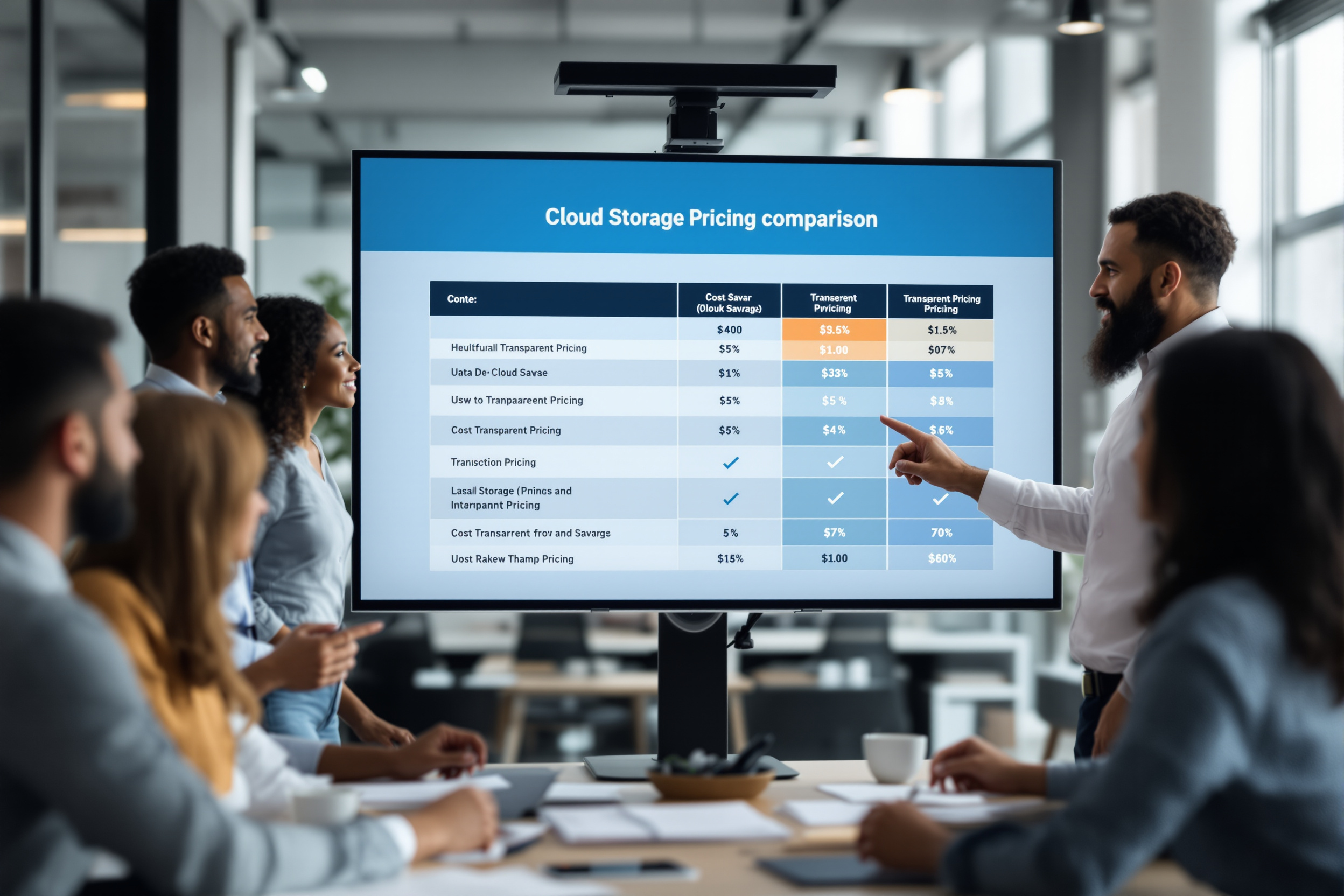Topics on this page
For IT leaders and MSPs, the search for a faster alternative to Backblaze is driven by two critical needs: performance and cost predictability. Traditional cloud storage often forces a trade-off, coupling slow data retrieval with complex pricing models where egress fees can inflate budgets by over 60%. This analysis explores a modern approach: an S3-compatible object storage solution built on an "Always-Hot" architecture. It delivers consistent, high-speed data access while eliminating the hidden fees that erode ROI, providing a strategic path to data control and financial clarity.
Key Takeaways
- A truly faster alternative to Backblaze must offer both superior performance, like 20% faster backups, and a predictable cost model that eliminates egress fees, saving 60-80%.
- An "Always-Hot" storage architecture is critical for performance, ensuring 100% of data is immediately accessible without the restore delays and hidden costs of tiered models.
- Enterprise-readiness requires full S3 compatibility for seamless migration, immutable storage for ransomware protection, and compliance certifications like SOC 2 and ISO 27001.
Escape the Hidden Costs of Traditional Cloud Storage
The number one pain point in cloud storage is cost unpredictability. Many enterprises find their budgets strained by surprise egress fees and API charges, which can make ROI calculations impossible. A company transferring 50TB of data per month could face over $54,000 in annual egress fees alone. This pricing model creates vendor lock-in, a strategic risk cited by 68% of CIOs who fear being trapped by proprietary APIs and punitive exit costs.
This financial friction penalizes data mobility and makes switching providers prohibitively expensive. Organizations report that hidden charges can inflate total cloud spend by 20-40%, turning seemingly affordable storage into a significant financial burden. A truly effective cloud storage alternative must address these economic traps head-on. The goal is to regain financial control and build a data strategy with a built-in exit plan, which requires a transparent economic model.
Demand an Enterprise-Ready S3-Compatible Architecture
S3 compatibility has become a baseline requirement for any modern storage solution, but not all offerings are equal. True enterprise-readiness means full API compatibility that supports advanced features like versioning and lifecycle management without code rewrites. This ensures that your existing investments in tools, scripts, and applications are protected, allowing for a seamless migration where you only change the endpoint. This level of integration is a core component of a practical object storage strategy.
A superior architecture is built for consistency and scale, delivering predictable latencies for mixed workloads. The key is an "Always-Hot" object storage model, where 100% of your data is immediately accessible. This design eliminates the operational complexity and restore delays common with tiered storage, which often lead to API timeouts and hidden fees. This architectural choice provides the foundation for both high performance and operational stability.
Achieve up to 20% Faster Performance with an 'Always-Hot' Model
Performance in cloud storage is about more than just throughput; it's about consistent and immediate data access. An "Always-Hot" architecture provides just that, ensuring all data is instantly available without the retrieval delays of minutes or hours found in tiered systems. This model can deliver up to 20% faster backup performance, a critical advantage for disaster recovery and business continuity. It simplifies operations by removing the need for complex and brittle lifecycle policies that often fail during urgent restores.
Here are the operational benefits of an always-accessible model:
- No Restore Delays: Eliminates waiting for data to be rehydrated from colder tiers, ensuring business operations continue without interruption.
- Predictable Application Behavior: Keeps third-party tools and custom applications stable, as they never encounter API timeouts from inaccessible data.
- Simplified Management: Removes the need to create, manage, and audit complex data lifecycle policies, reducing administrative overhead by over 30%.
- Strengthened Auditability: Guarantees that 100% of your data is available for compliance checks and audits at any time.
This approach transforms cloud backup from a passive archive into an active, resilient asset.
Eliminate 60-80% of Costs with a Transparent Economic Model
The most direct path to a lower Total Cost of Ownership (TCO) is a pricing model built on transparency. A faster alternative to Backblaze must also be more cost-efficient by design. By eliminating unpredictable charges, organizations can achieve 60-80% cost savings compared to traditional cloud storage. This is accomplished through a clear economic structure with zero egress fees, no API call costs, and no minimum storage durations.
This model provides the financial predictability needed for accurate budget planning. With egress fees sometimes costing as much as 70-90 € per terabyte with major providers, a zero-egress policy offers substantial savings. This allows you to retrieve your data as often as needed without financial penalty. It fundamentally breaks the vendor lock-in model and empowers you to maintain control over your data and your budget. This financial clarity is essential for building a sustainable and scalable data strategy.
Integrate Ransomware Protection and Enterprise-Grade Compliance
With backup infrastructure now a primary target for ransomware, robust security features are non-negotiable. Immutable storage via S3 Object Lock is a critical defense, ensuring that your backup data cannot be altered or deleted by attackers for a defined period. This capability is essential for business continuity and is increasingly a requirement for cyber insurance policies. It provides a guaranteed, unchangeable copy of your data for recovery.
Beyond security, enterprise-ready solutions must meet stringent compliance standards. Look for these key certifications:
- SOC 2: Verifies that the provider securely manages your data to protect the interests of your organization and the privacy of your clients.
- ISO 27001: Confirms the provider follows international best practices for information security management.
These certifications ensure the platform is suitable for regulated workloads in sectors like finance and healthcare. They provide third-party validation of enterprise-grade security without vendor lock-in. This combination of proactive threat defense and verified compliance is the hallmark of a truly enterprise object storage solution.
Enable MSPs with Predictable Margins and Simplified Management
For Managed Service Providers (MSPs), a faster alternative to Backblaze must also deliver a better business model. Predictable costs are the foundation of healthy, defensible margins for Backup-as-a-Service (BaaS) and DRaaS offerings. A zero-egress and zero-API-fee model means you can quote with confidence, as there are no surprise bills to erode your profits. This stability is a significant competitive advantage in a market where 53% of organizations exceed their cloud storage budgets.
A partner-ready platform should also simplify operations. Features like a multi-tenant console with role-based access control (RBAC) and MFA allow for secure management of multiple client accounts. Automation via API/CLI and integrated reporting tools reduce administrative overhead, allowing MSPs to onboard new clients in under 15 minutes. This operational efficiency enables you to focus on growth instead of managing complex billing.
Build a Practical Exit Strategy with S3 Compatibility and Data Portability
True data control means having the freedom to move your data whenever you choose. A built-in exit strategy is one of the most valuable features of a modern cloud storage solution. Full S3 compatibility is the first step, as it ensures you can migrate away from a provider without rewriting applications or disrupting workflows. This preserves your negotiation power and prevents the vendor lock-in that 71% of companies currently experience with their primary cloud provider.
The second critical component is the absence of financial penalties for leaving. A zero-egress-fee policy ensures data portability is not just a technical capability but a financial reality. This commitment to open standards and data freedom is a core principle of a customer-centric S3 object storage provider. It ensures you retain long-term control over your most valuable asset: your data.
More Links
Federal Statistical Office presents statistical data on cloud computing usage in enterprises in Germany.
Eurostat provides a news release focusing on the use of cloud computing by EU enterprises in 2023.
Bitkom offers a presentation regarding a cloud report for 2025, covering trends and developments in cloud computing.
eco links to a study about digital resilience in Europe with a focus on cloud computing, titled 'EuroCloud Pulse Check 2025'.
German Federal Ministry for Economic Affairs and Energy provides its Digital Strategy 2025, which likely includes aspects related to cloud computing.
Fraunhofer SIT offers information on cloud security, including research areas and services.
European Data Protection Board provides a document concerning cloud-based services for the public sector, focusing on data protection and compliance.
Gaia-X features an article discussing how cloud computing has centralized the internet, contrasting it with the original decentralized vision.
FAQ
What is an 'Always-Hot' storage model?
An 'Always-Hot' storage model ensures all data is stored in a high-performance tier and is immediately accessible at all times. This eliminates retrieval delays and extra fees associated with moving data from 'cool' or 'archive' tiers, simplifying operations and making restores faster and more predictable.
Can I use my existing backup tools with this type of storage?
Yes. A fully S3-compatible object storage solution works out-of-the-box with leading backup tools, scripts, and applications that use the S3 API. Migration is as simple as changing the endpoint in your software's configuration.
How does eliminating egress fees provide a better ROI?
By eliminating egress and API call fees, you remove the largest sources of unpredictable costs in cloud storage. This leads to a transparent, predictable pricing model that can reduce your total cost of ownership by 60-80%, allowing for more accurate budgeting and a higher return on your investment.
Is this type of storage secure enough for regulated industries?
Yes. Enterprise-grade solutions offer multi-layer encryption (in transit and at rest), immutable storage for ransomware protection, and robust identity and access management (IAM). Certifications like SOC 2 and ISO 27001 validate these security controls, making the storage suitable for regulated workloads.
What advantages does this model offer for MSPs?
For MSPs, a predictable cost model with no hidden fees allows for stable, defensible margins on BaaS and DRaaS offerings. Multi-tenant management consoles, automation via API/CLI, and quick onboarding simplify operations and support scalable growth.
What does a 'built-in exit strategy' mean?
A built-in exit strategy is created by combining full S3 API compatibility with a zero-egress-fee policy. This ensures you can migrate your data to another provider at any time without technical barriers or prohibitive financial penalties, giving you complete data control and independence.



.png)
.png)
.png)
.png)



.png)




%201.png)